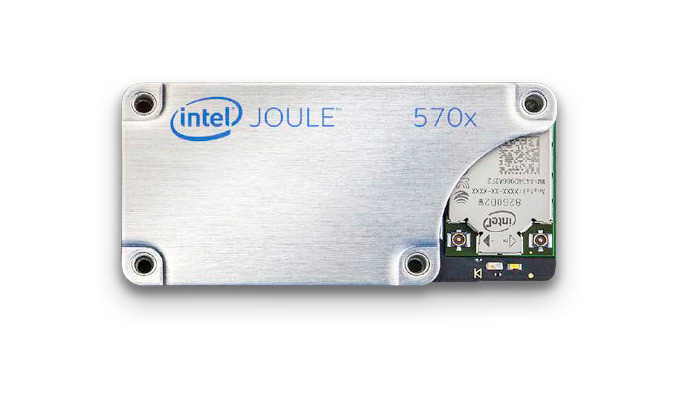Intel Unveils Joule: A High-Performance Atom-Powered IoT Module & Maker Kit
by Ryan Smith on August 17, 2016 4:30 AM EST
Today at Intel’s annual Developer Forum, the hardware manufacturer announced the latest in their Internet of Things-focused product kits: Joule. Based around Intel’s canceled-but-not-quite Broxton Atom processor, Joule is designed to further augment Intel’s existing lineup of kits by offering a much higher performance part based on the latest generations of the company’s technologies.
Back in 2013 Intel announced Galileo, the first of what has become a collection of IoT kits/platforms for hardware developers. Galileo and its compatriots Edison and Curie turned out to be solid hits for the company – even with competing kits already on the market – driving a big part of Intel’s overall IoT growth in recent years. The System on Module boards proved popular with tinkers and product developers alike who needed small systems for everything from small prototypes to a commercial off the shelf boards.
| Intel IoT Kits | |||||
| Joule 570X | Joule 550X | Edison | |||
| SoC | Intel Atom "Broxton-M" T5700 |
Intel Atom "Broxton-M" T5500 |
Intel Atom "Tangier" Z34xx |
||
| CPU | 4x Goldmont @ 1.7GHz, Turbo to 2.4GHz | 4x Goldmont @ 1.5GHz | 2x Silvermont @ 500MHz 1x Quark @ 100MHz |
||
| GPU | Intel Gen9 | Intel Gen9 | N/A | ||
| RAM | 4GB LPDDR4 | 3GB LPDDR4 | 1GB LPDDR3 | ||
| Storage | 16GB eMMC | 8GB eMMC | 4GB eMMC | ||
| Wireless | 802.11ac w/MIMO + BT 4.1 | 802.11n + BT 4.0 | |||
| I/O | UART + GPIO + I2C + MIPI CSI + MIPI DSI + USB 3.0 | SD + UART + SPI + GPIO + USB 2.0 OTG | |||
| Dimentions | 48 x 24 x 5 mm | 35.5 x 25 x 3.9 mm | |||
Joule then extends Intel’s presence in this market by offering a higher performing part in their IoT portfolio. Whereas the previous top-tier Edison board used a combination of Atom Silvermont and Quark CPU cores and paired this up with a respectable amount of RAM, NAND, and I/O options, Joule goes much further. The SoC at the heart of the board is Intel’s Broxton-M, which although was canceled for consumer devices, as we can now see will instead be making a home for itself within Intel’s IoT product family.
Intel is offering two different versions of the Joule board. Both use the same SoC, but they vary in clockspeeds and memory. The more powerful of the two, Joule 570X, uses what Intel is calling a Atom T5700, which is a quad core Goldmont Atom configuration with a base clock of 1.7GHz and can turbo to 2.4GHz. This in turn is paired with 4GB of LPDDR4 memory and a 16GB eMMC NAND module for non-volatile storage. Meanwhile the Joule 550X drops the quad core Atom to 1.5GHz with no turbo, and features 3GB of LPDDR4 memory along with 8GB of NAND.
Both Joule boards also feature the same I/O connectivity. On the wireless side, this is composed of a radio supporting Bluetooth 4.1 and 802.11ac (MIMO is listed supported, so I’m wagering this is a 2 spatial stream solution). And on the wired side, USB 3.0 is supported, along with the vast collection of GPIOs, UARTs, and MIPI’s camera (CSI) and display (DSI) interfaces.
The Joule module itself is said to only be a bit larger than the Edison module – which was usually measured relative to a postage stamp – and in the brief glimpse of the module we got when Brian Krzanich held it out on stage, I’d say we’re looking at something not too much bigger than a stick of gum (or perhaps the old Sony memory stick). Intel hasn’t released the full documentation for the kit yet, so we don’t have power consumption information available, but given the higher performance goals for the kit (and the quad Goldmont CPU cores), it’s a fair bet that it’s going to be higher than Edison.
As you might expect from the specifications, Intel is aiming Joule at a higher performance class of use cases. Ultimately as a maker kit it’s a bit of an “if you build it” situation – it’s up to developers to figure out what to do with it – but Intel sees it as being useful for drones, AR/VR, robotics, and for the first time in one of their IoT products, computer vision. While we don’t have a ton of hard details on the underlying iGPU, it is powerful enough for certain CV tasks, and it supports both 4K video capture and display. It also supports Intel’s RealSense camera, giving developers the option of using the underlying depth sensing capabilities for improved vision/analysis.
Finally, on the software side of matters, the Joule will support a few different OSes. The boards will default to a new Linux distribution specifically designed for the hardware that Intel is calling Reference Linux OS for IoT, and Cannonical’s “Snappy” Ubuntu Core is also supported. Meanwhile Microsoft’s Windows 10 IoT Core is also supported for developers who need Windows interoperability.
Wrapping things up, along with today’s announcement, Intel has already begun selling one of the Joule SKUs, with the others to follow. The Joule 570X development kit, which includes the Joule module, carrier board, WiFi antennas, and other components is on sale today at IDF for $369, and will be available through Intel’s partners next month. At that price it’s fair to say that Intel is not aiming to have Joule compete with more mainstream kits – or even their own Edison kit – but rather at the more upscale kits such as the (even more expensive) NVIDIA Jetson TX1, which is a much tighter market in terms of the number of competitors.
Meanwhile the lower-end 550X development kit and the stand-alone Joule modules are scheduled for release in Q4. Pricing for those products has not yet been disclosed, though given the intent for Joule to be used in mass production devices, it’ll be interesting to see what Intel prices the stand-alone modules at.
Source: Intel












60 Comments
View All Comments
Daniel Egger - Wednesday, August 17, 2016 - link
> Can someone tell me WTF is "internet of things", and what are the applications here?Easy: It's not defined so you get to make up anything that your imagination provides. Really the only restriction is that whatever you're thinking of has to be /somehow/ connected to the internet. Let me give you an example: You have a Philips Hue light with a remote -> Not IoT, you also have a Hue bridge and the light is paired with it -> IoT. The idea behind IoT is that once you have many of those internet enabled things available you can magically combine them into useful applications but what those might be is anyones best guess, especially when it comes to a useful involvement of the internet not only for the connection but also for the orchestration part.
jospoortvliet - Sunday, August 21, 2016 - link
Quite true, though IoT generally doesn't include independent computing devices (laptops) or such but is about an (for now largely imagined) wave of super small connected thingies and networked intelligence added to existing devices. So yeah, lights, fridges, bikes, doors, doorbells, and so on... the complaint that this Intel "IoT" device seems only to have that name for marketing purposes is valid, most of the examples of IoT you hear and see are centered around miliwatts consuming, cents-costing additions to existing devices. It is, at the very least, a stretch from Intel marketing to call this an IoT device.jospoortvliet - Sunday, August 21, 2016 - link
Fully agreed. Reading IoT and then quadcore, 4gb ram... - I am sorry, what? What wearable devise is useful with two seconds of battery life? This is a neath device, absolutely, but claiming it is even remotely related to IoT is marketing bullshit. You measure IoT power usage in miliwatts, in the tens to hundreds... and costs has to be in the cents range for it to be relevant.Again, this is cool for some embedded use cases, but even in a big drone it's power usage is likely to be an order of magnitude too big and calling an average drone an IoT device is already stretching the definition beyond reason... maybe micro drones could be but they would be the same size as this whole Joule module ;-)
Arnulf - Wednesday, August 17, 2016 - link
Priced for a glorious fail. Alas.trintdune - Wednesday, August 17, 2016 - link
One of the most poorly written and unintelligible headlines I've ever seen in my life. Seriously, go back and read it again! It even popped up on google news this way! Total gibberish to most people- is Andandtech's proof-editor dead?jordanclock - Wednesday, August 17, 2016 - link
Seems perfectly legible to me as is:Intel Unveils Joule: A High-Performance Atom-Powered IoT Module & Maker Kit
Are you seeing something different?
MrSpadge - Wednesday, August 17, 2016 - link
+1trintdune - Wednesday, August 17, 2016 - link
yes it was jibberish, really funny. looks like they corrected it now to only marginally readable, still bad grammar.It used to read "Intel Unveils Joule: "An" High-"Perofromanace" AtomPower IoT Module Maker Kit" what?? seriously some people didn't read well in school. Literally a very poorly constructed sentence, don't abbreviate IoT as well as other nonsense. for example, is it a 'module-maker'? or a 'maker kit'? See what I mean? There's no indication....combine that with IoT and you have still a laughable sentence with too many subjects and no commas- a bit like "A purple plebian perplexed DHL jargon floating banana wrench kit file adaptation maker kit IoT." Wow! yes, like that one.
kgardas - Wednesday, August 17, 2016 - link
It's quite powerful so I would expect this to be IoT gw, but for this I would also expect it to have ECC RAM. Even Quark SoC supports that so what's the point intel? https://www.supermicro.nl/products/system/Compact/...smilingcrow - Wednesday, August 17, 2016 - link
ECC hardly seems essential for this class of device!